
| Manitou Springs, Colorado |
|---|
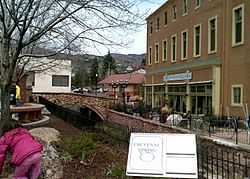 |
Cave of the Winds is a cave in the Pikes Peak region of Colorado. It is located just west of Colorado Springs on U.S. Highway 24, near the Manitou Cliff Dwellings. Tours of the complex of caves are given daily.

| Manitou Springs, Colorado |
|---|
 |
Cave of the Winds is a cave in the Pikes Peak region of Colorado. It is located just west of Colorado Springs on U.S. Highway 24, near the Manitou Cliff Dwellings. Tours of the complex of caves are given daily.

By far the most famous section of the Cave of the Winds is the Silent Splendor room. Discovered in 1984, [1] the room contains numerous rare crystalline speleothems including helictites which appear to defy the laws of gravity by growing in strange directions and not being forced down by gravity like many cave formations. However, the room must be sealed off from the general public in order to maintain its delicate environment. Silent Splendor is sealed from public view by an "environmental gate" with a large tube that seals in moisture to maintain the atmosphere necessary for the delicate formations to continue to grow.
In the late 1980s, a few new passages were opened inside the cavern. On May 8, 1988, Mother's Day, [2] a chamber called the "Adventure Room" was opened. Left in a more natural state than most of the cave, the Adventure Room has dirt floors, lower numbers of lights (compared to other chambers inside the cave) and gives entry to the Manitou Grand Caverns where Lantern Tours are given.[ citation needed ]
In 1989, a new passage named "Old Curiosity Shop" was opened, billed as the most narrow passage in the Cave of the Winds. Traversing it gains a look at the "Colorado Rose", a beaded helictite, and "Spider Web Valley", a collection of delicate helictites. This passage was opened to make tour groups moving through "Tall Man's Headache, Fat Man's Misery" a little easier.[ citation needed ]
Other lesser known attractions include a "bottomless pit", often the scene of practical jokes by the guides. The site also features a free-fall amusement ride called the Terror-Dactyl. [3]

It is believed that both Apache and Ute Native Americans knew about the cave. The name, Cave of the Winds, relates to a legend involving the Apache, who were said to believe the cave was the home of a Great Spirit of the Wind.
The first documented mention of the cave came in 1880 when two brothers, John and George Pickett, discovered the cave during a hike in Williams Canyon led by the Rev. Roselle T. Cross, pastor of the Congregational Church in Colorado Springs. The boys noticed that their candles flickered in a small shelter cave they had found and wind was seen to be blowing from a nearby crevice. Crawling through the opening they emerged into a large chamber. Within a few days, Cross wrote about the discovery of the cave in his church newsletter and his story was immediately reprinted in the Colorado Springs Gazette of July 2, 1880.
The Colorado Encyclopedia relates: "Although Cross exaggerated the heights and depths of vertical elements, as do most inexperienced cavers, his account is remarkably free of the florid Victorian hyperbole typical of most cave descriptions of that time. Cross and his Boys’ Exploring Association explored most of the horizontal passages accessible from the original entrance, a distance of about 200 feet—a respectable distance for schoolboys using candles." [4] [5]

In 1880, the same year that the cave was discovered, George Washington Snider, a stonecutter from Ohio who had traveled to Colorado seeking his fortune visited the cave. Snider excavated passages from the Williams Canyon caves, as they were then called, and discovered "Canopy Hall" -- a large room nearly 200 feet long containing thousands of stalactites and stalagmites.. Snider wrote, “It was as though Aladdin with his wonderful lamp had effected the magic result." Unfortunately Snider spoke of his discovery in town and the next day the cave was mobbed by townspeople who stripped the cavern of many of the stalactites. [4]
Snider continued to excavate and began preparations for guided tours. The Cave of the Winds quickly became one of the established attractions of the young Manitou resort area. Cave of the Winds has been in continuous operation since 1881 – making it one of Colorado’s oldest visitor attractions. Electrical lights were added in 1907, and visitors began traveling to the cave in even greater numbers – first by carriage and railroad, and later by car. [5]
The cost has increased over the years. In 2023 the admission price was USD$27 for adults, USD$18 for age 4 to 12.


About 500 million years ago during the Ordovician period warm shallow seas covered the Pikes Peak region of Colorado. The seas were home to abundant shell creatures that accumulated on the sea floor when they died. The layers built up for millions of years and were eventually compacted and hardened into the rock known as limestone. The geological name for the limestone layer found in the cave is Manitou Limestone. [6]
About 70 million years ago the shallow seas receded and the area was lifted forming the Rocky Mountain region. About 4 to 7 million years ago the limestone fell below the water table Rainwater mixed with carbon dioxide, forming a weak carbonic acid that slowly ate away at the limestone, forming pockets. The pockets slowly enlarged forming passageways and caverns. [7] [6]
In the short steep drive up Williams Canyon to the cave entrance one can view several different depositions of limestone. During the Devonian period the Williams Canyon Limestone was laid down and during the Mississippian period the Leadville Limestone layer was deposited. [8]


As the water table dropped within the cave system air began to fill the passageways and caverns. Stalactites formed on the cave's ceilings as calcium carbonate-rich water dripped leaving thin calcite rings that grew into icicle-like shapes over thousands of years. Through the same process stalagmites grew from the cave floors. A third type of structure is called flowstone. Flowstone formations are curtain-like formations that flow along the sides of caverns or passages. They are the most common formation found in "solution caves" in limestone, such as Cave of the Winds. Sometimes called draperies or curtains, they are formed over thousands of years as the mineral-rich water flows over surfaces leaving calcite behind. [6]
The rarest and most delicate formations are called helictites. Helictite forms have been described in several shapes: "hands", ribbon helictites, saws, rods, butterflies, curly-fries, and "clumps of worms". They can be easily broken by the slightest touch and consequently are set away from tour groups. As helictites grow, they change their axis from the vertical at one or more stages of growth, hence the "clumps of worms" description for one type. Several theories as to how and why they defy gravity have been suggested but no theory has yet been proven to be correct.

A stalactite is a mineral formation that hangs from the ceiling of caves, hot springs, or man-made structures such as bridges and mines. Any material that is soluble and that can be deposited as a colloid, or is in suspension, or is capable of being melted, may form a stalactite. Stalactites may be composed of lava, minerals, mud, peat, pitch, sand, sinter, and amberat. A stalactite is not necessarily a speleothem, though speleothems are the most common form of stalactite because of the abundance of limestone caves.

A stalagmite is a type of rock formation that rises from the floor of a cave due to the accumulation of material deposited on the floor from ceiling drippings. Stalagmites are typically composed of calcium carbonate, but may consist of lava, mud, peat, pitch, sand, sinter, and amberat.

A speleothem is a geological formation by mineral deposits that accumulate over time in natural caves. Speleothems most commonly form in calcareous caves due to carbonate dissolution reactions. They can take a variety of forms, depending on their depositional history and environment. Their chemical composition, gradual growth, and preservation in caves make them useful paleoclimatic proxies.

Kartchner Caverns State Park is a state park of Arizona, United States, featuring a show cave with 2.4 miles (3.9 km) of passages. The park is located 9 miles (14 km) south of the town of Benson and west of the north-flowing San Pedro River. Long hidden from view, the caverns were discovered in 1974 by local cavers, assisted by state biologist Erick Campbell who helped in its preservation.

Luray Caverns, previously Luray Cave, is a cave just west of Luray, Virginia, United States, which has drawn many visitors since its discovery in 1878. The cavern system is adorned with speleothems such as columns, mud flows, stalactites, stalagmites, flowstone, and mirrored pools. The caverns host the Great Stalacpipe Organ, a lithophone made from solenoid-fired strikers that tap stalactites of varied sizes to produce tones similar to those of xylophones, tuning forks, or bells.
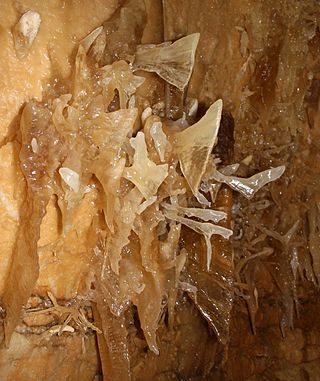
A helictite is a speleothem found in a limestone cave that changes its axis from the vertical at one or more stages during its growth. Helictites have a curving or angular form that looks as if they were grown in zero gravity. They are most likely the result of capillary forces acting on tiny water droplets, a force often strong enough at this scale to defy gravity.

Florida Caverns State Park is a state park of Florida in the United States, part of the Florida State Parks system. It is located in the Florida Panhandle near Marianna. It is the only Florida state park with air-filled caves accessible to the public.

Treak Cliff Cavern is a show cave near Castleton in Derbyshire, England. It is part of the Castleton Site of Special Scientific Interest and one of only two sites where the ornamental mineral Blue John is still excavated. As part of an agreement with English Nature, the Blue John that can be seen in the show cave is not mined but it is extracted in small quantities from other areas of the cave and made into saleable items like bowls, jewellery, and ornaments.
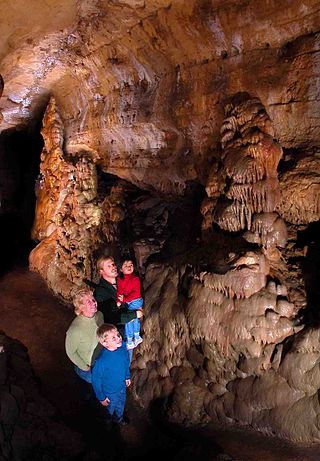
Cave of the Mounds, a natural limestone cave located near Blue Mounds, Wisconsin, United States, is named for two nearby hills called the Blue Mounds. It is located in the southern slope of the east hill. The cave's beauty comes from its many varieties of mineral formations called speleothems. The Chicago Academy of Sciences considers the Cave of the Mounds to be "the significant cave of the upper Midwest" because of its beauty, and it is promoted as the "jewel box" of major American caves. In 1987, the United States Department of the Interior and the National Park Service designated the cave as a National Natural Landmark.

Black Chasm Cavern is a cave in the hamlet of Volcano in Amador County, California.
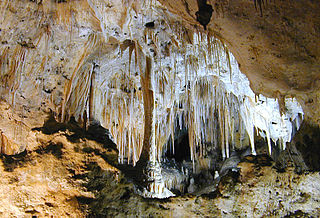
Carlsbad Caverns National Park is an American national park in the Guadalupe Mountains of southeastern New Mexico. The primary attraction of the park is the show cave Carlsbad Cavern. Visitors to the cave can hike in on their own via the natural entrance or take an elevator from the visitor center.

Rimstone, also called gours, is a type of speleothem in the form of a stone dam. Rimstone is made up of calcite and other minerals that build up in cave pools. The formation created, which looks like stairs, often extends into flowstone above or below the original rimstone. Often, rimstone is covered with small, micro-gours on horizontal surfaces. Rimstone basins may form terraces that extend over hundreds of feet, with single basins known up to 200 feet long from Tham Xe Biang Fai in Laos.

Grand Caverns, formerly known as Weyer's Cave, is located in the central Shenandoah Valley in the town of Grottoes, Virginia, United States. A limestone cavern, it claims the distinction of being America's oldest show cave, in operation since 1806.
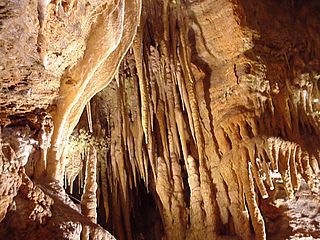
Crystal Grottoes is the only show cave in the U.S. state of Maryland. It is located on Maryland Route 34 between Boonsboro and Antietam National Battlefield.

Boyden Cavern is a show cave located in the Giant Sequoia National Monument of the Sequoia National Forest, along the Kings Canyon Scenic Byway in Fresno County, California. It is just west of Kings Canyon National Park.

The Lake Shasta Caverns are a network of caves located near the McCloud arm of Shasta Lake in California. It was formerly named Chalk Cave and Baird Cave, named after Spencer Fullerton Baird.
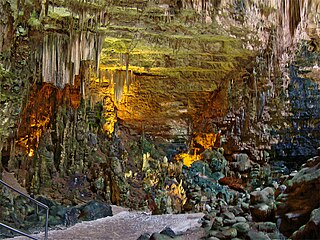
The Castellana Caves are a karst cave system located in the municipality of Castellana Grotte, in the Metropolitan City of Bari, Apulia, southern Italy.

A solutional cave, solution cave, or karst cave is a cave usually formed in the soluble rock limestone. It is the most frequently occurring type of cave. It can also form in other rocks, including chalk, dolomite, marble, salt beds, and gypsum.
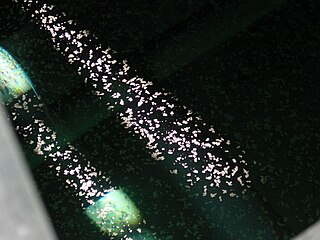
Calcite crystals form on the surface of quiescent bodies of water, even when the bulk water is not supersaturated with respect to calcium carbonate. The crystals grow, attach to one other and appear to be floating rafts of a white, opaque material. The floating materials have been referred to as calcite rafts or "leopard spots".

Indiana Caverns is part of the Binkley Cave system near Corydon, Indiana.
![]() Media related to Cave of the Winds (Colorado) at Wikimedia Commons
Media related to Cave of the Winds (Colorado) at Wikimedia Commons